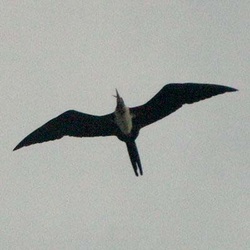 Character Body size (76 cm).
Males: All-black fur, white patches on the hull sides and bottom of the wing base. Pouch red beak.
Females: black fur. Brownish head. White patches on the belly. Little white spot at the base of the wing.
Teens: Body brownish black. Head, neck, chest, stomach side red white and brown.
Iris brown, gray beak, legs dark red. Life in the sea, soaring above the surface following the hot air, following the fish group. Sometimes flying fast and low over the sea with a heavy beating. Capture prey in the sea without landing. Sometimes resting perched on poles or trees on small islands.
Food: fish and other animal body parts, dead or alive.
Habitat Sea Coast.
Deployment Breeding: Cocos Rivet, P. Christmas, Australia.
Tropical oceans.
Local Deployment Tambaksari, Sayung, Demak: wetland areas. Status Guest.
Very small amount and frequency is very rare.
Rating encounter: (5) very difficult.
 Character Body of medium size (61 cm).
Black with green or purple sparkle. Closing wing gray, the black wings and looks flaky.
Breeding: white patches on the side of the head and behind the eyes.
Teens: Colored more murky, brownish spots. Leather front and pockets blue gray beak.
Iris green, gray beak, black legs. Generally small groups or alone.
Food: Fish. Nesting in colonies with other water birds. Nest of twigs on top of a pile of mangroves.
Sea-green eggs, covered with a layer of lime, elongated shape, the number of items 2-3.
Breeding between December to March.
Habitat Lakes, ponds, estuaries, sea, pond.
Deployment Australia, Indonesia, Sunda Large.
Sumatra, Borneo, Java, Bali, Sulawesi, Nusa Tenggara, Maluku, Papua.
Local Deployment Tambaksari, Sayung, Demak: wetland areas.
Status Settlers.
The number and frequency were rare.
Rating encounter: (3) moderate.
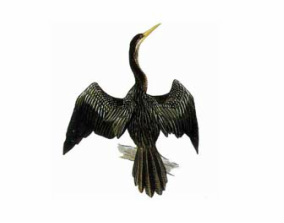 Character Body size (84 cm).
Water birds such as pecuk with very long and slender neck. Small narrow head. Head and neck brown, no white chin stripe along the neck. Other parts blackish fur, fur cover soft white with a black edge.
Iris brown, yellowish brown beak, gray legs. Being able to dive in the long term. Able to reduce buoyancy, which looks just the head alone time swimming. Feathers absorb water, flapping wings and running on the water while flying. Perched long to dry hair. Gathered in groups on the bare tree.
Food: Fish. Nesting in colonies with other water birds. Nest is a pile of twigs in tall trees near the beach.
Eggs are whitish, the number of items 2-4.
Breeding months of December to March, March to June.
Habitat In the vast puddles, lakes, large rivers.
Spread to a height of 1400 m above sea level.
Deployment India, Southeast Asia, the Philippines, Sunda Large.
Sumatra, Borneo, Java, Bali, Sulawesi, Nusa Tenggara, Maluku, Papua.
Local Deployment Wanawisata Penggaron, Ungaran.
Status Guest. Approaching endangered (Near Threatened).
Very small amount and frequency is very rare.
Rating encounter: (5) very difficult.
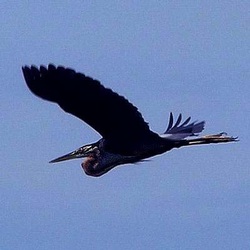 Character Body size (80 cm).
Gray color chestnut brown, black.
Black hat. Black stripe along the neck of the red-rust. Back and wing cover gray, black fur fly.
Iris yellow, half-brown, reddish-brown legs. Crept along the shallow waters alone, head lowered down and to the side to catch prey. Fly with flapping heavily and slowly.
Food: fish, frogs, reptiles, insect larvae, crustaceans. Nesting solitary or in large colonies. Nest of twigs in the pile of reed grass or small trees above the water.
Breeding months of December to March, from February to August.
Habitat Wetlands are not confined to the coast, mangroves, paddy fields, lakes, streams, hills sometimes.
Spread to a height of 1,500 m above sea level.
Deployment Africa, Eurasia, the Philippines, Sunda Large.
Sumatra, Borneo, Java, Bali, Sulawesi, Nusa Tenggara.
Local Deployment Whole observatories, Tugu, Semarang: wetland area
Kaliwungu, Kendal: wetland area
Tambaksari, Sayung, Demak: wetland areas.
Status Settlers.
Quantities and frequencies often.
Rating encounter: (1) very easy. Sound Sound an alarm call.
Tinjomoyo, Gunungpati, Semarang - © Baskoro Description:
Sound an alarm call "uncle" harsh.
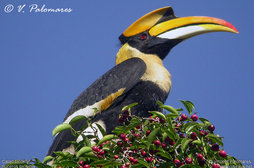 Hornbill board or its scientific name Buceros bicornis is the largest species of bird in the tribe Bucerotidae. Adult birds are very large, with a length of 160cm. This bird has black feathers and yellow-black horns on the big yellow beak. Skin of his face black with fur collar khaki. Tail feathers are white with a thick black line in the middle. Board hollow horn hornbill bird and not solid. Female birds are smaller than males. Males and females can be distinguished easily from his eyes. Female birds eye is blue, while the red-eyed males.
Board hornbill populations scattered in tropical forests in India, China, Indochina, Nepal, Bhutan, Peninsular Malaysia and Sumatra, Indonesia. Hornbill bird feed Board consists of various fruits, small animals, birds, insects and reptiles. Hornbill monogamous, only pairs with a opposite sex.
Board hornbill nest in tree holes. At the time of laying eggs, female birds cooped up in a tree hole almost entirely covered with mud, until the young birds start big. At this time, females and young birds birds depend entirely on male birds to feed through a small gap is left open
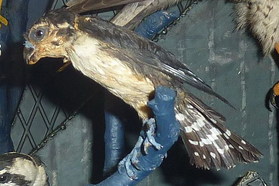 Latin Name : Microhierax fringillarius
English Name: Black-thighed Falconet
Character
The body is small (15 cm).
Upper body is black, with white spots on the secondary feathers inside. White chest. Rust-red belly. Thigh black. The front and black earmuffs, surrounded by white streaks or smears.
Iris dark brown, gray beak, gray legs.
Perch to wait for prey. Capture prey with quick movements and re-perch.
Food: dragonflies, butterflies, insects.
Nest of bark coating or dragonfly wings, the tree hole.
Eggs are cream-colored, dark-bright spots, the number of items 2-5.
Breed in November-December.
Habitat
Edge of the forest, gardens, rice fields.
Spread to a height of 1,000 m above sea level.
Deployment
Peninsular Malaysia, the Great Sunda.
Sumatra, Borneo, Java, Bali.
Local deployment
Medini, Limbangan, Kendal: the edge of primary forest, tea plantations.
status
Settlers. CITES II.
The number is very few and rare frequency.
Rating encounter: (4) is rather difficult.
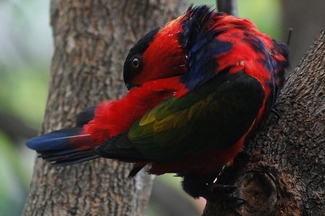 Indonesia Name: Nuri kepala Hitam
Common Name : Black Caped Lory
Latin Name: Lorius lory
Description:
Bird parrot is a bird species of the most brilliant color of their feathers among members of the parrot. The colors of feathers that owned such as red, blue, yellow and green, and black are very striking. Having a body length of 30-50 cm. His eyes are yellow, brownish yellow beak. Specific characteristics warana fur on the top of the head is black. At the tip of his tongue like organ found threads of fine and short that serves to help eat the grain and get pollen.
Behavior: In its natural habitat, these birds live in groups, either being perched, flying and looking for food. Preferred perch in the tree canopy that opens to the outside. Sound conceited to be issued, both are flying and was perched, but was eating.
Reproduction: Birds Nuri females lay eggs 3-4 items, placed in the nest, the eggs incubated alternately between the male and female parent.
Feed: The types of bird feed preferred form of fruits, seeds, flowers, pollen, honey, insects and insect larvae.
Habitat: tropical forest, wooded, savanna. Spread in Maluku and Papua.
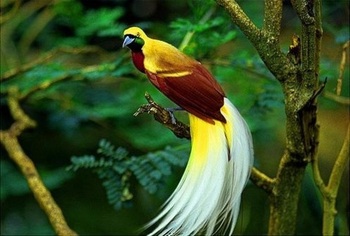 Birds Cendrawasih which is a typical bird of Papua, especially the males, have beautiful feathers like an angel coming down from heaven (heaven). Matchless beauty of Cendrawasih feathers.
Birds Cendrawasih is a collection of bird species are grouped in families Paradisaeidae. The bird is only found in eastern Indonesia, Papua New Guinea, and Australia's east and consists of 14 genera and about 43 species. The 30's of species of which can be found in Indonesia.
In Papua, birds of paradise is believed to be the incarnation of an angel from heaven. This bird was once considered a beautiful bird but no legs. They will not turung to the ground but just being in the air just because beautiful feathers. Since then Cenderawasih bird known as Bird of Paradise or Birds of Paradise (Heaven).
Description and characteristics of Paradise
Birds of paradise feathers have a beautiful characteristic possessed by male birds. Generally brightly colored feathers with a combination of multiple colors like black, brown, red, orange, yellow, white, blue, green and purple.
Size Cenderawasih bird diversity. Ranging from the size of 15 cm with a weight of 50 grams as the type Cendrawasih King (Cicinnurus regius), up to a size of 110 cm Cendrawasih Part Sabit Black (Epimachus albertisi) or weighing up to 430 grams as in Cendrawasih Manukod Jambul-rolled (Manucodia comrii ).
The beauty of the male Cendrawasih feathers used to attract the opposite sex. To 'seduce' the female to be willing to be invited mating, males will show off their feathers by performing dances beautifully. While singing in the branches, swaying with the movement of males in different directions. In fact, sometimes up hanging upside down resting on the limb. However, each species of Cendrawasih must have its own type of dances.
Bird Cendrawasih has a dense forest habitat is generally in the low-lying areas. Bird of paradise can be found on several islands in eastern Indonesia such as Maluku and Papua. It can also be found in Papua New Guinea and East Australian.
 Size is rather small (50 cm). Reddish brown, black, and white, with a short crest. Adults: crown, cheeks, and lower body blackish; brown tail with a thick black line and a white tip.
Chin, throat, and chest black and white streaked; side of the body, abdomen, thighs, and under tail reddish brown with black streaks stomach. At the time flying round pale spots visible on the base of the primary feathers. Teens: upper body dark brown with black spots on the eyes. Eyebrow and lower body putihan.Iris whitish red, half black, and yellow legs sera.
sound:
High cry "cirrep", preceded by initial tones are high. Also shouts high "kliu".
Global deployment:
Southern India, Himalay, southeast Asia, the Philippines, Sulawesi and the Great Sunda.
Local spread:
Occupants are not common in the forest to a height of 1500 m in the Great Sunda.
Habit:
Inhabit the forest at the edge of the forest, seen spinning or gliding low over the trees. Fly around teretori, fast attack prey on the ground or in the canopy of trees, similar to the Peregrine Falcon.
Food:
Eat birds including pheasant and pigeon. Among other mammals also eat squirrels.
Breeding:
Breeding season from December to March in South Asia. Large nest built by a pair of parent in the highest canopy trees in a dense forest. 1 egg are incubated alternately by parent, very aggressive in defending the nest when there is a bully.
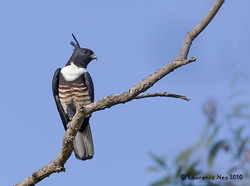 Black Baza
Aviceda leuphotes
Description
Small size (32 cm), easily recognizable, black and white. Long black crest and often lifted up. The majority of black fur, with a white stripe on the chest, white mottled wings, and abdomen dark striped ribbon. At the time flies, short rounded wings patterned stripes of black and gray secondary feathers (in contrast to the pale feathers tipped black primer). Wings like a raven, wings flat while gliding.
Iris dark brown, horn-colored beak with sera gray, dark gray legs.
Sound
Weak, one to three thin scream tone, like the sound of seagulls.
Not yet available sound recordings taken from the territory of Indonesia.
Distribution and Race
Himalayas, southern India, southern China, Southeast Asia. Winter visitors to Sumatra, rarely to West Java.
Known there are four sub-species with a distribution area:
wolfei Deignan, 1948 - Sichuan (central China).
Syama (Hodgson, 1837) - India's northeastern and eastern Nepal to southern China (Guangdong, Hainan); winter migrating south through Indochina and Peninsular Malaysia to Sumatra and Java.
leuphotes (Dumont, 1820) - India's southwestern, southern Myanmar and western Thailand; probably also breeds in some parts of Indochina.
andamanica Abdulali & Grubh, 1970 - Kep. Southern Andaman.
Religious Life and Habits:
Inhabit the entire rain forest from the bottom until it reaches an altitude of 1800 m above sea level. However, more usually found ranging from a height of 200-1800 m above sea level. Live in pairs or in small groups. Fly short distances, flapped snatching insects in the air or on the ground. Rather benign. Often found along streams or in open woods and villages. When migrating flying high in the sky.
|










 RSS Feed
RSS Feed